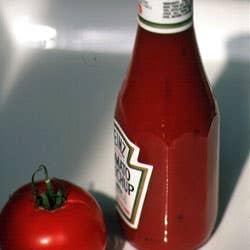
Seeing Red
Ketchup or catsup? Vegetable or fruit? It doesn’t matter to the folks who use it on everything from burgers to eggs.
It's found in 97 percent of America's kitchens! It's served in nine out of ten American restaurants! It's as popular as superstars like salt, pepper, and sugar! It's pure, natural, unadulterated! It's sweet, it's tangy, it's mild, it's hot! You don't need teeth to eat it! Toddlers like it! Tibetans like it! It's on hot dogs, macaroni, and meat loaf! It's on the Internet!
Hey, if it's such a big deal, how come you don't know how to pronounce it, can't spell it, and aren't sure what it really is? Welcome to the wonderful, wacky world of ketchup. Or catsup. Or catchup. Which was originally ke-tsiap, a 17th-century Chinese brine of pickled fish and spices. Which was subsequently translated into an early 18th-century English sauce of mushrooms, walnuts, and cucumbers. Which was penultimately a late 18th-century homemade American condiment that standardized tomatoes as the main ingredient. Which ultimately evolved into a thick, rich, mass-produced, bottled tomato condiment introduced by Henry Heinz in 1876 as Tomato Catsup—just seven years after he started out selling horseradish and a year after a costly cucumber crop nearly put him out of business. Whew!
Heinz eventually popularized the use of ketchup as the pre-eminent spelling. And while some of the smaller brands still call it catsup, the Big Three national manufacturers—Heinz, Hunt's, and Del Monte—all use the ketchup appellation. Furthermore, while ketchup can be made from carrots, beets, bananas, or cabbage, all store-bought American ketchup is tomato ketchup, based on a "Standard of Identity" issued by the U.S. government on January 1, 1940.
Enough with what it's called. What kind of food is it? It starts life as an edible fruit, gets categorized by the USDA as a vegetable, and winds up in McDonald's as a condiment. A fruit, a vegetable, a condiment; a sauce, a cooking ingredient. We're talking a food with a severe identity crisis, bordering on a multiple-personality disorder. Which seems extremely unfair, considering what a simple food it really is.
Ketchup is made from just a few ingredients: lots of tomatoes, a touch of white vinegar, some corn syrup, salt, and natural flavorings. From late August to early October, most ketchup is made from fresh tomatoes. The rest of the year, tomato paste is used instead of fresh tomatoes, with no discernible taste difference. Every manufacturer's recipe varies slightly, and there are differences from country to country. Heinz, for example, produces a sweeter ketchup for the English than for us, while for Central Europeans the formula is made spicier. The exact Heinz recipe is a closely held secret, although some years ago we discovered that clove oil gives the brand its unique flavor.
The gold standard of ketchup makers is a product that is as thick and rich as possible. Heinz somehow manages to squeeze about 24 of its own specially bred tomatoes (hardy, thick-skinned, disease-resistant, high on meatiness, low on juice) into every 14-ounce bottle.
With so many of these babies going into a bottle, Heinz likes to brag that theirs isn't just the thickest and richest ketchup in the world, it's also the slowest. Which leads to another crucial ketchup-lovers' question: How do you get the stuff out of the bottle? According to the experts at Heinz, you do not pound the bottle from the bottom (it could explode) and you never stick your knife into it to make it pour (unsanitary). Here's a little physics tip: Hold the glass bottle at a horizontal angle, position your index finger directly under the raised "57" stamp on the side, and tap sharply three or four times. This should break the natural seal inside the bottle and start a gentle flow. Or give up and buy the squeezable plastic container.
Once you get it out, where does ketchup go? In America it goes on hamburgers, hot dogs, french fries, and meat loaf. It even goes into the filling of Love Apple Pie—love apple being a translation of the French phrase for tomato, pomme d'amour. You won't be surprised to read that Americans are the biggest consumers of ketchup in the world. And the biggest American consumers are the smallest: Kids under the age of 12 eat more ketchup than anybody else. It's bright red, sweet, gloppy, a potential mess, and if you pour enough on your plate, you can disguise the taste of almost any vegetable your mother gives you.
Clearly, ketchup leads a charmed life. It's got many of the attributes we'd all like to have: it's rich, bright, popular, dependable, adaptable, and well respected. So wouldn't you just know there's trouble in paradise? A south-of-the-border rival, salsa, is mounting a challenge for condiment supremacy. What's salsa got that ketchup doesn't? It's newer, spicier, and just foreign enough to appeal to younger, more adventuresome palates.
Never fear, ketchup lovers. The continued success and prosperity of ketchup is in no immediate danger. Sure, mustard lovers are a loyal group. Relish people will talk your ear off about sweetness versus tang. But only one condiment in the entire world could inspire the immortal poetry of cybernaut Kendall L. Black—half Emily Dickinson, half Ogden Nash:
Ketchup is good … ketchup is great …
I always put some on my plate.
It's red … it's sweet … it's quite a treat …
I have to have it when I eat …
Keep Reading
Continue to Next Story










